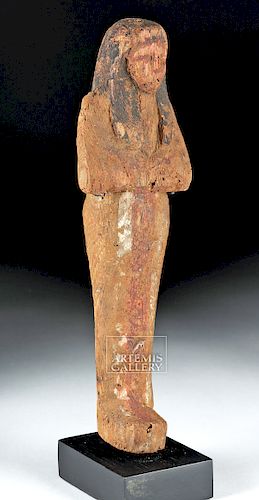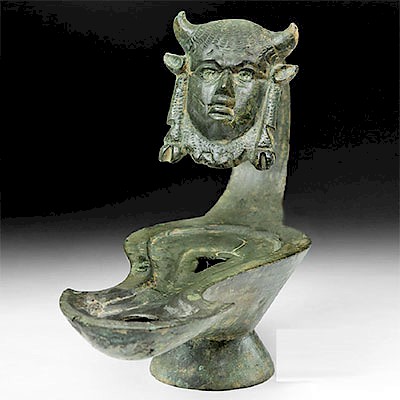Egyptian New Kingdom Wooden Painted Ushabti
Lot 3
About Seller
Artemis Fine Arts
686 S Taylor Ave, Ste 106
Louisville, CO 80027
United States
Selling antiquities, ancient and ethnographic art online since 1993, Artemis Gallery specializes in Classical Antiquities (Egyptian, Greek, Roman, Near Eastern), Asian, Pre-Columbian, African / Tribal / Oceanographic art. Our extensive inventory includes pottery, stone, metal, wood, glass and textil...Read more
Estimate:
$1,200 - $1,500
Absentee vs Live bid
Two ways to bid:
- Leave a max absentee bid and the platform will bid on your behalf up to your maximum bid during the live auction.
- Bid live during the auction and your bids will be submitted real-time to the auctioneer.
Bid Increments
| Price | Bid Increment |
|---|---|
| $0 | $25 |
| $300 | $50 |
| $1,000 | $100 |
| $2,000 | $250 |
| $5,000 | $500 |
| $10,000 | $1,000 |
| $20,000 | $2,500 |
| $50,000 | $5,000 |
| $100,000 | $10,000 |
| $200,000 | $20,000 |
About Auction
By Artemis Fine Arts
Sep 27, 2018
Set Reminder
2018-09-27 10:00:00
2018-09-27 10:00:00
America/New_York
Bidsquare
Bidsquare : Antiquities | Asian | Ethnographic
https://www.bidsquare.com/auctions/artemis-gallery/antiquities-asian-ethnographic-3469
Featuring classical antiquities, ancient and ethnographic art from cultures encompassing the globe. Artemis Fine Arts info@artemisfinearts.com
Featuring classical antiquities, ancient and ethnographic art from cultures encompassing the globe. Artemis Fine Arts info@artemisfinearts.com
- Lot Description
Ancient Egypt, New Kingdom period, 19th Dynasty, ca. 1320 to 1200 BCE. A beautiful, hand-carved wooden ushabti of an elegant presentation. The figure stands in mummiform atop projecting feet and slender legs, with both arms bent at the elbow. Rounded shoulders trace upwards to a stylized red-painted head which dons a jet-hued tripartite wig. Though faded, the painted designs would have displayed the figure holding the symbolic pick and hoe - in order to maintain the sacred fields of Osiris in the afterlife - as well as a column of hieroglyphic text down the legs. Remains of the original black, red, and white pigmentation nicely complement the wheat hue of the wood. Wooden ushabti are of far greater rarity than their faience or stone counterparts, making this an exceptional example from ancient Egypt! Custom wooden display stand included. Size: 2.375" W x 8.25" H (6 cm x 21 cm); 9" H (22.9 cm) on included custom stand.
Ushabti dolls are figures shaped like adult male or female mummies wearing traditional ancient Egyptian headdresses. The ancient Egyptians believed that after they died, their spirits would have to work in the "Field of Reeds" owned by the god of the underworld, Osiris. As a result, they are frequently depicted with arms crossed, holding picks and hoes, with baskets on their backs. This meant that the task of agricultural labor was required by all members of society, from workers to pharaohs. The wealthier nobility in Egyptian society were able to have ushabti made of faience, though wood was a more economical option for members of lower classes.
Provenance: private Houston, Texas, USA collection
All items legal to buy/sell under U.S. Statute covering cultural patrimony Code 2600, CHAPTER 14, and are guaranteed to be as described or your money back.
A Certificate of Authenticity will accompany all winning bids.
We ship worldwide and handle all shipping in-house for your convenience.
#132836Surface wear commensurate with age, small nicks to feet, body, and head, fading and abrasions to facial features and pigmentation, with inactive insect damage, otherwise very good. Nice earthen deposits and pigmentation remains throughout.Condition
- Shipping Info
-
All shipping is handled in-house for your convenience. Your invoice from Artemis Gallery will include shipping calculation instructions. If in doubt, please inquire BEFORE bidding for estimated shipping costs for individual items.
-
- Buyer's Premium



 EUR
EUR CAD
CAD AUD
AUD GBP
GBP MXN
MXN HKD
HKD CNY
CNY MYR
MYR SEK
SEK SGD
SGD CHF
CHF THB
THB














